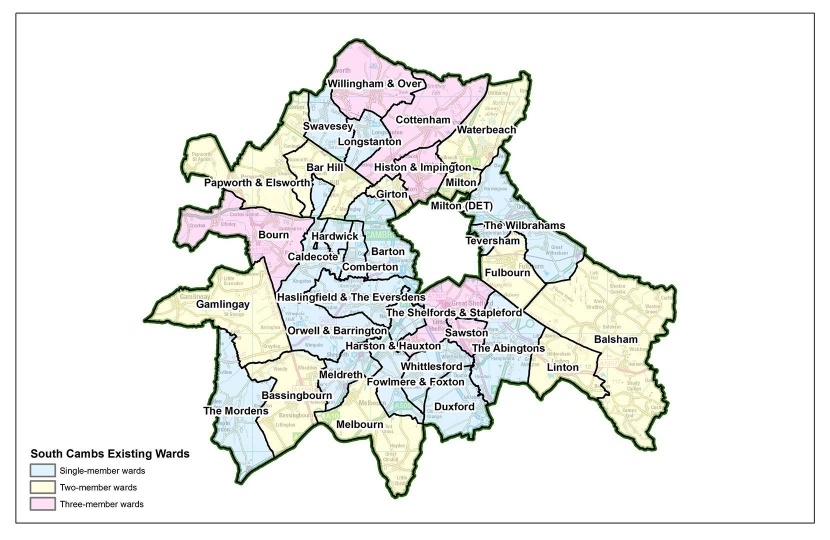
A new pattern for council wards across South Cambridgeshire has been announced by the independent Local Government Boundary Commission for England (LGBCE).
From May 2018, the number of councillors representing communities on South Cambridgeshire District Council will decrease from 57 to 45.
The new boundaries are being put into place to ensure ach councillor represents roughly the same number of voters. Where possible, the boundaries also reflect the interests and identities of communities across the area.
Draft proposals put forward by the Commission in May for areas around Gamlingay and The Mordens to become one ward with two councillors have been changed. Following consultation responses, the Commission concluded that two separate single councillor wards would better reflect community ties – which is disputed on the ground as Hatley (pop 175) has very strong ties with Gamlingay, which is four miles away, and none with the majority of other villages in the new warding. See 'comment' below.
Cllr Alex Riley, South Cambridgeshire District Council’s Member champion for the Boundary Review, said: “As a Council, we want to reassure residents that no changes will come into effect before May 2018, and the move to these new wards will be fully publicised and explained ahead of those elections.”
May 2018 will also see the Council move to all-out elections, with all 45 Council seats up for election at once every four years, moving away from the current arrangements of a third of seats up for election over a three year cycle.
Full details of the final ward boundary recommendations are available on the Commission’s website.
The proposed new arrangements must now be implemented by Parliament. A draft Order – the legal document which brings into force the recommendations – will be laid in Parliament in the coming months. The draft Order provides for the new electoral arrangements to come into force at the council elections in 2018.
Comment from Peter Mann, resident of East Hatley (and webmaster for this website)
Having campaigned to keep Hatley parish (comprising the villages of East Hatley and Hatley St George) as part of the Gamlingay ward, he responded to a survey by The Local Government Boundary Commission for England, which it circulated immediately after it announced its final recommendations, with these points:
This is a comment on the Gamlingay and The Mordens wards – and the lack of a fair democratic process in future.
I live in Hatley and objected (as did Hatley Parish Council) to the original (November 2015) concept of Hatley being left out of the proposed Gamlingay ward, for it ignored the historic and cultural ties between Hatley and Gamlingay, which are four miles apart.
I also felt – and still do – the proposal at the time for Hatley to be part of The Mordens ward would not favour small villages like Hatley which are some distance from the Mordens: if the councillor lived in the much larger Mordens area would he / she routinely come to Hatley?
Your response in February 2016 was to make Gamlingay a two member ward to include The Mordens on the basis it helped you to square your self-imposed mathematics of every councillor being 'responsible' for a specific number of constituents.
However, it did not address a key point – Gamlingay is the powerhouse in the ward giving the sitting councillors home advantage at election time over candidates living in the south of ward.
Reverting in October 2016 to your original plan of separate wards with Hatley again outside Gamlingay means... well, we all wasted our time putting our points to you.
But even with your obsession with mathematics, you seem to have overlooked the enormous difference in the duties expected of a councillor, for the Gamlingay councillor will have only 22 parish council meetings to attend per year in a single village whereas the councillor for The Mordens will have 50+ meetings spread over a geographical area four times as large, doubtless many of the meetings clashing.
You have also overlooked, it seems, the comments made by Councillor Bridget Smith in her submission in July 2016 that very large wards discourage all but a few who have the time and resources to become councillors.
You may feel by equalising the number of constituents per councillor and giving voters the perceived benefit of voting once every four years (as opposed to annually in some wards currently), you are serving the needs of democracy – as I have pointed out above, the process you are thrusting upon us will be far from democratic in practice, for it both discourages anyone from wanting to become a councillor unless they have independent means and it is not conducive to them having the time or inclination to serve geographically large wards, especially if they live at one of the far boundaries.
You may feel ‘Job done’ – but have you done a good job?
There has been no response to these comments from LGBCE.
-----------------------------------------------------------------------------------------
South Cambridgeshire District Council
T 03450 450 500
F 01954 713 149
E [email protected]
T @SouthCambs
W www.scambs.gov.uk
Your local District and County Councillors
District Council List of all councillors
County Council List of all councillors

